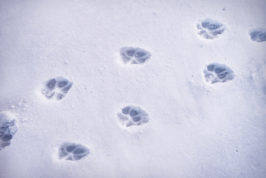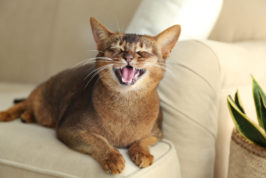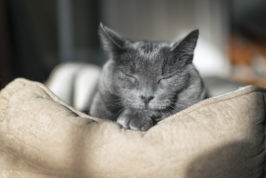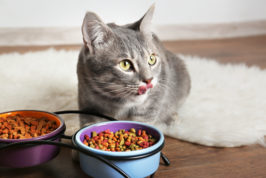What to feed a cat with Diarrhoea
There are several things to think about when deciding what’s best to feed a cat with Diarrhoea. Each individual cat will have different requirements, depending on the cause of the Diarrhoea and whether any other health conditions are present. Dr Gemma Cliffin explains the best way to tackle the condition with your feline…
Should I starve my cat?
In the past, it’s been recommended that animals with Diarrhoea should be starved for 24 to 48 hours to ‘rest the gut’. It’s now thought that it’s actually best to continue to feed your pet, rather than withhold food. This is to keep your cat’s digestive system moving, and provide the nutrition he or she requires to heal and regain normal function.
Continuing to feed is especially important in cats. Unlike dogs, they can develop a liver condition called Hepatic Lipidosis (fatty liver), if they are starved for too long. It’s a potentially very serious condition, where the function of the liver is compromised as a direct result of a cat not eating for a while – usually three to four days.
What should I feed my cat?

For most cats suffering from Diarrhoea, a vet would recommend a bland food diet. But what exactly does that mean? For dogs, it refers to a home-cooked diet of boiled chicken and rice, but it’s important to note that cats have different nutritional requirements to dogs.
For starters, cats have a lower tolerance for dietary fibre than dogs, and a higher requirement for fat and protein. For that reason, feeding a feline boiled chicken on its own, without the addition of rice, is preferred. However, this is not a nutritionally complete diet, as it’s lacking a lot of essential nutrients. For a single day, it’s unlikely to matter, but for any longer it’s best to seek an alternative route.
For those who don’t wish to feed home-cooked food, there are commercial prescription diets available from your vet. These are specially formulated to be highly digestible and ensure easy absorption of nutrients. They’re also low in fat, with an increased level of electrolytes and B vitamins to replace nutrients that have been lost through the episode of Diarrhoea. These are also nutritionally complete, therefore suitable for cats experiencing Diarrhoea for longer than a few days (also known as Chronic Diarrhoea).
Wet or dry food?
Commercial foods usually come in both wet and dry forms, in order to appeal to cats that may prefer one over the other. Feeding wet food may be advantageous over dry food, as it’ll help to replace fluid loss caused during the episode of Diarrhoea. However, some cats can be notoriously fussy and ensuring that they continue to eat is one of the most important factors when deciding what diet to feed!
Once your cat’s Diarrhoea has resolved and he or she is passing solid stools, you can slowly reintroduce normal food over a five to seven day period, by gradually increasing the amount of regular food fed at each meal.
Probiotics and prebiotics
There are products containing probiotics and/or prebiotics that may help to aid your cat’s recovery.
Probiotics are live microorganisms sometimes referred to as ‘the good bacteria’ that live in the gut. Prebiotics are a source of food for these good bacteria, which will help to promote their growth.
These supplements are designed to be given on top of your cat’s food, and sometimes contain a binder that’ll help firm up your cat’s faeces. These products are widely used in veterinary practices, and have been shown to help resolve cases of Acute Diarrhoea in cats more quickly. More research is needed to determine how helpful probiotics are in cases of Chronic Diarrhoea.
Homecare modifications
Cats with Diarrhoea will often drink more than they usually would, in order to replace the fluid lost in their faeces. You can help to encourage water intake by providing multiple water sources for your cat. Cats prefer to drink from moving water rather than standing water, and you can buy pet fountains to enable this.
Your cat may need extra rest to recover from their bout of Diarrhoea, so make sure there are plenty of places to sleep undisturbed. It might be a good idea to provide your cat with a litter tray inside if he or she doesn’t already have one. This could help prevent any unwanted accidents in the house!
When should I take my cat to the vet?
You should contact your vet if your cat is displaying any of the following signs in addition to Diarrhoea:
- Extreme tiredness or weakness
- Pain – either in the tummy or when passing faeces
- Blood in the faeces
- Loss of appetite
- Vomiting
- Has any other health conditions or is taking any other medication
- Is very young or elderly
- No improvement after two or three days
- Has Diarrhoea intermittently for two weeks or more
Conclusion
For a short, mild episode of Diarrhoea, it may be possible to help your cat at home by feeding small meals of cooked chicken or a highly digestible prescription diet. Never withhold food from your cat, even if the Diarrhoea is bad. The addition of probiotics and prebiotics to your cat’s diet may help to speed up the recovery process. However, if your cat becomes poorly, stops eating, or the Diarrhoea is not resolving, take them to the vet to get checked over.




